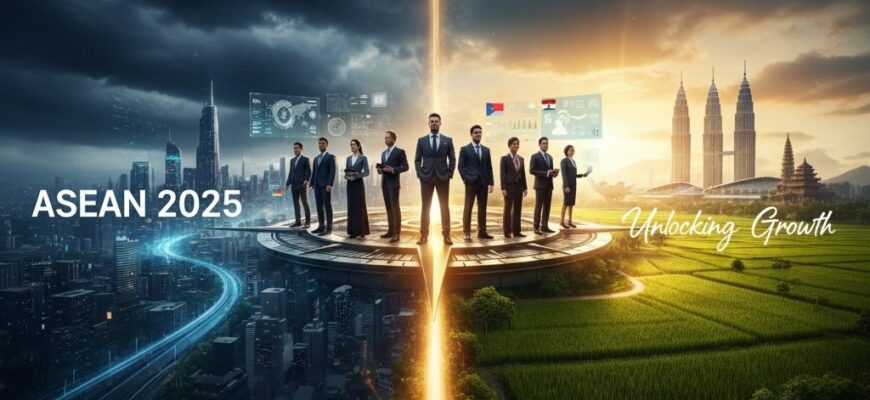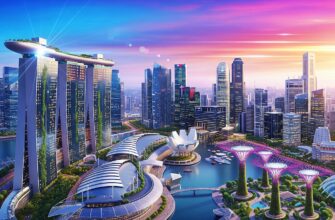- Executive Summary: The 2025 ASEAN Imperative
- Introduction: Why ASEAN Is No Longer an Option, But a Necessity
- Chapter 1: ASEAN as a Unified Economic Powerhouse (A Regional Overview)
- 1.1. The Macro-Economic Pulse in 2025
- 1.2. The Megatrends Defining ASEAN’s Future
- Chapter 2: Deep Dive: ASEAN Country Profiles
- 2.1. Singapore: The Unrivaled Command Center
- 2.2. Indonesia: The Demographic Powerhouse
- 2.3. Vietnam: The Manufacturing Dragon
- 2.4. Thailand: The Value-Added Hub
- 2.5. Malaysia: The Semiconductor Powerhouse
- 2.6. The Philippines: The Services and Youth Market
- 2.7. The Frontier Markets: Cambodia, Laos, Brunei & Myanmar
- Chapter 3: The Web of Opportunity: Navigating Trade Agreements
- Chapter 4: Cross-Regional Investment Opportunities by Sector
- Chapter 5: A Comparative Analysis for Strategic Decision-Making
- Conclusion: The ASEAN Strategic Imperative for 2025 and Beyond
Executive Summary: The 2025 ASEAN Imperative
- A Resilient Growth Engine: Amidst global economic turbulence, the ASEAN bloc remains a critical growth hub. However, initial optimism has been tempered by external headwinds. The consensus forecast for regional GDP growth in 2025 has been revised to a robust but realistic 4.1% – 4.6%.
- The De-Risking Destination: As American companies continue to execute the “China+1” strategy to de-risk their supply chains, ASEAN nations like Vietnam, Malaysia, and Thailand are the primary beneficiaries, creating immense industrial and logistical opportunities.
- A Digital Nation in the Making: With over 500 million internet users, ASEAN’s digital economy is on track to hit a Gross Merchandise Value (GMV) of nearly $400 billion in 2025. E-commerce, FinTech, and the creator economy represent a massive, still-untapped market.
- A Tale of Two Tiers: The region is not a monolith. Success requires a nuanced strategy distinguishing between the hyper-advanced command center of Singapore, high-growth manufacturing powerhouses like Vietnam, the demographic giant of Indonesia, and specialized, value-added hubs like Malaysia and Thailand.
- Key Action Items: U.S. businesses must leverage the RCEP trade agreement to optimize supply chains, invest in local talent to navigate complex regulatory environments, and forge strong local partnerships to unlock access to a burgeoning middle class of over 400 million consumers.
Introduction: Why ASEAN Is No Longer an Option, But a Necessity
In the C-suite and on the boardroom floor, the global map is being redrawn. For the past decade, the Association of Southeast Asian Nations (ASEAN) has been a rising star; in 2025, it has become the strategic center of gravity for global growth and supply chain resilience. To view this region as a collection of disparate, secondary markets is to fundamentally misread the economic landscape. With a combined GDP set to exceed $4.1 trillion, a population of over 685 million—younger and more digitally native than Europe or North America—ASEAN is a formidable economic power.
Against a backdrop of persistent global uncertainty and geopolitical friction, ASEAN offers a compelling proposition: diversification, dynamism, and demographics. The “China+1” concept has moved from theory to practice, becoming a core pillar of corporate strategy for American firms. It is the factory floors of Vietnam, the semiconductor plants of Malaysia, and the EV assembly lines of Thailand that are absorbing this strategic shift.
This guide is engineered for strategists, not tourists. It provides a data-driven, fact-checked roadmap for navigating the complexities and seizing the monumental opportunities across the ASEAN landscape in 2025. We will dissect the regional megatrends, conduct a deep dive into each of the ten member states, untangle the web of trade agreements, and spotlight the most lucrative investment sectors. Welcome to the world’s most dynamic economic arena.
Chapter 1: ASEAN as a Unified Economic Powerhouse (A Regional Overview)
1.1. The Macro-Economic Pulse in 2025
While ASEAN is a mosaic of ten unique nations, its economic integration under the ASEAN Economic Community (AEC) framework makes it a unified force.
- Population: ~685 million people. The region’s demographic dividend is its superpower: over 60% of the population is under 35.
- Combined GDP: Projected to reach approximately $4.1 trillion by year-end 2025.
- Economic Growth: Demonstrating remarkable resilience, ASEAN is forecasted to grow between 4.1% and 4.6%in 2025—a rate that significantly outpaces developed economies. Growth is fueled by robust domestic consumption, massive government infrastructure spending, and strong foreign direct investment (FDI) inflows.
- Foreign Direct Investment (FDI): The region remains a top destination for FDI, having attracted over $230 billion in 2024. The U.S., Japan, and the EU are key investors, with intra-ASEAN investment also on the rise.
- Trade: Total trade in goods exceeds $3.5 trillion, deeply integrating ASEAN into global value chains for electronics, automotive parts, and apparel.
1.2. The Megatrends Defining ASEAN’s Future
- The Digital Revolution is Total and Irreversible:
- Connectivity: Over 500 million active internet users form a massive digital market.
- Digital Economy GMV: On track to reach $380-$400 billion in 2025, dominated by e-commerce, food delivery, online media, and a booming FinTech scene.
- FinTech Disruption: Digital payments are now mainstream. Mobile wallets, QR codes, and Buy Now, Pay Later (BNPL) platforms are achieving explosive growth, particularly in Indonesia, Vietnam, and the Philippines.
- The Green Transition and Sustainability:
- Renewable Energy: Governments are aggressively promoting solar, wind, and geothermal projects. Investment potential is enormous, especially in Indonesia and Vietnam.
- Electric Vehicles (EVs): Thailand is positioning itself as the “Detroit of Asia” for EVs, backed by huge subsidies. Indonesia is leveraging its world-leading nickel reserves to build an end-to-end battery supply chain.
- The Great Supply Chain Realignment:
- “China+1” in Action: Companies are diversifying their manufacturing footprint to mitigate geopolitical risk. Vietnam has become an electronics assembly titan, Malaysia a critical hub for semiconductors, and Thailand a linchpin for automotive components.
- Infrastructure Build-out: Hundreds of billions are being invested in ports, highways, rail lines, and industrial parks to support this manufacturing shift.
- Urbanization and the Rise of the Consumer Class:
- Urban Growth: An additional 90 million people are expected to move to ASEAN cities by 2030.
- Purchasing Power: The middle class is projected to encompass 65% of the population by 2030, driving insatiable demand for high-quality consumer goods, healthcare, education, and financial services.
Chapter 2: Deep Dive: ASEAN Country Profiles
This section provides a strategic analysis of each of the 10 member nations.
2.1. Singapore: The Unrivaled Command Center
- At a Glance: Population: ~5.9M | GDP: ~$520B | GDP per Capita: ~$88,000
- 2025 Economic Outlook: The service- and tech-driven economy shows mature growth, with the official forecast for 2025 revised to a steady 1.5% – 2.5%. The nation continues to grapple with a high cost of living and an aging population.
- Investment Climate & Opportunities: A world-class financial hub, ideal for regional headquarters, asset management, and FinTech innovation. Government grants aggressively target biotech, AI, and cybersecurity R&D. Its port remains the world’s busiest transshipment hub, making it the perfect base for regional supply chain management.
- Bottom Line for U.S. Business: Don’t view Singapore as a market, but as a launchpad. Use its unparalleled legal system, financial infrastructure, and talent pool to establish your regional HQ and orchestrate expansion into the rest of ASEAN.
2.2. Indonesia: The Demographic Powerhouse
- At a Glance: Population: ~280M | GDP: ~$1.5T | GDP per Capita: ~$5,300
- 2025 Economic Outlook: The largest economy in ASEAN, with growth projected at a strong 4.8% – 5.1%, driven by massive domestic consumption. The new administration is continuing pro-investment policies focused on infrastructure and downstream processing of natural resources.
- Investment Climate & Opportunities: Home to the region’s largest e-commerce market and a hotbed for FinTech. A global leader in nickel, it’s building a powerhouse EV battery industry by mandating in-country processing. The multi-hundred-billion-dollar relocation of the capital to Nusantara presents a once-in-a-generation opportunity for construction, smart city tech, and infrastructure firms.
- Bottom Line for U.S. Business: The market with the single greatest long-term potential. Success requires patience, a long-term strategy, and a strong local partner to navigate the bureaucracy. The digital sector offers the fastest point of entry.
2.3. Vietnam: The Manufacturing Dragon
- At a Glance: Population: ~100M | GDP: ~$480B | GDP per Capita: ~$4,800
- 2025 Economic Outlook: One of the world’s fastest-growing economies, with 2025 growth forecast at a blistering 6.0% – 6.2%. It remains the undisputed champion of the “China+1” manufacturing shift.
- Investment Climate & Opportunities: A global manufacturing hub for tech giants like Samsung, Apple (via Foxconn), and Intel. Strong in traditional sectors like apparel and furniture, and rapidly growing in renewable energy. Its participation in major trade pacts like CPTPP and the EU-Vietnam FTA (EVFTA) provides unparalleled export advantages.
- Bottom Line for U.S. Business: The premier destination for manufacturing diversification. Requires meticulous due diligence on provincial infrastructure and local partnerships.
2.4. Thailand: The Value-Added Hub
- At a Glance: Population: ~70M | GDP: ~$550B | GDP per Capita: ~$7,800
- 2025 Economic Outlook: The region’s second-largest economy faces headwinds from a weaker global export market. The 2025 growth forecast has been significantly revised downwards to 2.3% – 2.8%. The government is pushing the “Thailand 4.0” innovation agenda to counter these challenges.
- Investment Climate & Opportunities: The “Detroit of Asia” is aggressively courting EV manufacturers, especially from China. It remains a powerhouse in electronics and automotive components. World-class wellness and medical tourism sectors offer premium opportunities. The Eastern Economic Corridor (EEC) offers some of the best investment incentives in the region.
- Bottom Line for U.S. Business: Ideal for higher-value manufacturing, R&D, and regional headquarters for industrial operations. The current economic slowdown could present strategic M&A opportunities.
2.5. Malaysia: The Semiconductor Powerhouse
- At a Glance: Population: ~34M | GDP: ~$450B | GDP per Capita: ~$13,200
- 2025 Economic Outlook: A well-diversified economy with a strong export sector, projected to grow at a healthy 4.5% – 5.0%.
- Investment Climate & Opportunities: A critical node in the global semiconductor supply chain, controlling an estimated 13% of the world’s assembly, testing, and packaging market. A rapidly growing destination for data centers and a global leader in Islamic finance. High English proficiency and excellent infrastructure are major draws.
- Bottom Line for U.S. Business: The top choice for integrating into the high-tech global supply chain, particularly in semiconductors. Political stability remains a key factor to monitor.
2.6. The Philippines: The Services and Youth Market
- At a Glance: Population: ~118M | GDP: ~$470B | GDP per Capita: ~$4,000
- 2025 Economic Outlook: Driven by services and remittances from its massive overseas workforce, the economy is projected to grow at a robust 5.8% – 6.2%.
- Investment Climate & Opportunities: A global leader in the Business Process Outsourcing (BPO) industry, from call centers to game development. The very young, English-speaking population creates a dynamic consumer market. The government’s “Build Better More” program is focused on urgently needed infrastructure upgrades.
- Bottom Line for U.S. Business: The go-to destination for service-based operations targeting a global, English-speaking clientele. The consumer market holds huge potential but requires deep localization.
2.7. The Frontier Markets: Cambodia, Laos, Brunei & Myanmar
- Cambodia: Economy is driven by textiles and tourism. Growth forecast for 2025 has been lowered to ~4.0-4.5%due to external demand shifts. Offers low-cost labor but faces challenges with infrastructure and rule of law. Best for labor-intensive manufacturing for firms with a high risk tolerance.
- Laos: The landlocked “Battery of ASEAN” relies on hydropower exports. The new China-Laos railway presents new logistics opportunities. However, high public debt and soaring inflation (~13.5%) are major concerns. Niche opportunities in energy and transit logistics.
- Brunei: An oil- and gas-dependent economy attempting to diversify. A very small, highly regulated market with niche opportunities in Halal food and ecotourism.
- Myanmar: Remains in a deep political and economic crisis following the 2021 military coup. The investment climate is extremely high-risk. Most U.S. and Western firms have ceased or suspended major operations.
Chapter 3: The Web of Opportunity: Navigating Trade Agreements
Understanding the trade agreement landscape is essential for optimizing any ASEAN strategy.
- RCEP (Regional Comprehensive Economic Partnership): This is the game-changer. As the world’s largest free trade bloc (ASEAN + China, Japan, South Korea, Australia, New Zealand), RCEP simplifies rules of origin, streamlines customs, and harmonizes trade regulations. For U.S. businesses with manufacturing in ASEAN, RCEP is the framework for building a cost-effective, resilient regional supply chain.
- CPTPP (Comprehensive and Progressive Agreement for Trans-Pacific Partnership): A higher-standard agreement with members including Singapore, Vietnam, Malaysia, and Brunei. It offers superior access to markets in Canada and Latin America and enforces strong standards on labor, e-commerce, and intellectual property.
- Bilateral FTAs: ASEAN as a bloc, and its individual members, have numerous other Free Trade Agreements (FTAs) that can be leveraged to optimize tax and tariff structures for export.
Chapter 4: Cross-Regional Investment Opportunities by Sector
- The Digital Economy:
- FinTech: Target the massive underbanked populations in Indonesia, the Philippines, and Vietnam with digital lending, payment, and insurance solutions.
- Data Centers: Demand is exploding. Singapore is the premium hub, while Malaysia and Indonesia offer rapidly growing, lower-cost alternatives.
- The Green Economy:
- Renewables: Vietnam (solar, wind), Indonesia (geothermal), and the Philippines (wind) require massive investment in both power generation and grid modernization.
- EV Ecosystem: Thailand is the assembly hub, Indonesia controls the battery materials, and the entire region needs a charging infrastructure build-out.
- Advanced Manufacturing & Supply Chains:
- Semiconductors: Focus on Malaysia for assembly and testing, Vietnam for its growing capabilities, and Singapore for chip design and R&D.
- Medical Devices & Pharma: Singapore for high-value R&D, while Thailand and Malaysia are strong in manufacturing generics and medical equipment.
Chapter 5: A Comparative Analysis for Strategic Decision-Making
Table 1: Macroeconomic Snapshot (2025 Forecasts)
| Country | GDP (Nom.), $B | GDP Growth | Population, M | GDP per Capita, $ |
| Indonesia | 1,510 | 4.8-5.1% | 280 | 5,300 |
| Thailand | 550 | 2.3-2.8% | 70 | 7,800 |
| Vietnam | 480 | 6.0-6.2% | 100 | 4,800 |
| Philippines | 470 | 5.8-6.2% | 118 | 4,000 |
| Malaysia | 450 | 4.5-5.0% | 34 | 13,200 |
| Singapore | 520 | 1.5-2.5% | 5.9 | 88,000 |
Table 2: Business Environment & Cost Estimates
| Country | Operating Environment | Corruption Perception Index (Rank) | Avg. Mfg. Wage, $/mo | Prime Office Rent (CBD), $/sqm/mo |
| Singapore | World-class, transparent, highly regulated | 5 | ~3,500 | 80-120 |
| Malaysia | Strong, pro-business, good infrastructure | 61 | ~800 | 15-25 |
| Thailand | Developed, pro-investment, EEC incentives | 101 | ~450 | 25-40 |
| Vietnam | Rapidly improving but bureaucratic | 77 | ~350 | 20-35 |
| Indonesia | Complex bureaucracy, improving with reforms | 110 | ~300 | 18-30 |
| Philippines | Bureaucratic, improving FDI laws | 116 | ~320 | 20-35 |
Sources: IMF, World Bank, ADB, Transparency International, consulting firm estimates for 2025. Ranks and figures are indicative.
Methodological Note on Business Environment: The World Bank discontinued its “Ease of Doing Business” report in 2021. Its successor, “Business Ready,” is still in early stages and does not yet cover all ASEAN nations comparably. The qualitative assessments above are based on a synthesis of available data on regulatory transparency, infrastructure, and legal frameworks.
Conclusion: The ASEAN Strategic Imperative for 2025 and Beyond
For American business leaders, the question is no longer if they should be in ASEAN, but how and where. The region presents an unparalleled convergence of demographic growth, digital adoption, and strategic importance in a reconfiguring global order. However, this is not a market for those seeking short-term gains. Success demands a deep respect for local nuance, a long-term commitment to building relationships, and the agility to adapt to a rapidly shifting landscape.
Final Questions for Your Leadership Team:
- What is our strategic objective? Are we seeking a new consumer market, a manufacturing base to de-risk our supply chain, or an innovation hub?
- How should we structure our entry? A regional HQ in Singapore with operating subsidiaries? A direct investment? Or a joint venture with a local champion?
- How can we leverage RCEP and CPTPP to design the most tax- and tariff-efficient supply chain possible?
- Where will we find and how will we develop the talent needed to win?
Success in ASEAN is not a short-term venture; it demands sustained commitment and strategic patience. The companies that invest the time and resources today to truly understand this vital and complex region will be the ones leading the global economy tomorrow. The window of opportunity is open now, and the primary question is how decisively one chooses to act.






